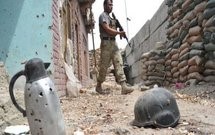 As the United States continues to debate whether it will withdraw its troops from Afghanistan entirely after 2014 -- dubbed by Washington as the "zero option" -- the government in Kabul continues to rely heavily on the U.S. and NATO presence. The Pentagon noted as much in a report released to the U.S. Congress on July 30. Afghan President Hamid Karzai is well aware of this reliance, and even though Kabul and Washington disagree on several matters, including customs issues and the post-2014 status of forces agreement, he understands that the onus is on him to resolve these disputes. His administration simply cannot survive the zero option.
As the United States continues to debate whether it will withdraw its troops from Afghanistan entirely after 2014 -- dubbed by Washington as the "zero option" -- the government in Kabul continues to rely heavily on the U.S. and NATO presence. The Pentagon noted as much in a report released to the U.S. Congress on July 30. Afghan President Hamid Karzai is well aware of this reliance, and even though Kabul and Washington disagree on several matters, including customs issues and the post-2014 status of forces agreement, he understands that the onus is on him to resolve these disputes. His administration simply cannot survive the zero option.
The Afghan National Security Forces have progressed considerably. A decade ago they did not exist, and now they are leading the fight against the Taliban. But the fact remains that NATO forces, particularly U.S. forces, enabled that progression through their assistance in various domains, including air assets and logistical support. Most important, the Afghan National Security Forces will cease to exist without the estimated $4 billion to $6 billion in foreign funding Kabul is expected to receive after 2014.
The Afghan National Security Forces became as large as they are ever going to be (roughly 330,000) in April 2012, and for the most part they have been able to sustain that level. As NATO forces drew down over the past year, the Afghan National Security Forces increasingly bore the brunt of Taliban fighting, and their casualty rates have risen accordingly. Of course, casualty rates fluctuate with Afghanistan's fighting seasons, but by March 2013 some 325 Afghan servicemen were killed per month, up from 75 per month in January 2012.
In addition to casualty rates, desertion rates are also elevated -- an average of 2.5 to 4.1 soldiers desert every month. The Afghan National Security Forces thus rely on a steady stream of new recruits to replenish their ranks, making the NATO training mission all the more important. Such training is particularly critical for developing Afghan soldiers with advanced logistical, maintenance, artillery and counter-improvised explosive device skills -- areas in which the Afghan National Security Forces are lacking expertise.
As NATO has drawn down its presence and patrols, the Taliban have conducted more effective IED attacks, according to the U.S. Joint Improvised Explosive Device Defeat Organization. Taliban bombers have more time to deploy the devices and operate under less pressure simply because there is less security on Afghan roads. These attacks have been particularly deadly for Afghan forces. In addition, because of the reduced foreign troop presence, the Talban reportedly have been able to push Afghan forces out of some rural areas in the south and east.
Another area of concern is air power. The Afghan National Security Forces have begun to develop a nascent air force capability thanks to Western training and aviation assets, such as the Mi-17 transport helicopters purchased by the United States from Russia. The Afghan air force has begun to participate in and carry out a number of missions, but its aircraft are unreliable and poorly maintained. The Afghan National Security Forces still rely extensively on NATO for medevac, close air support and transport as well as for intelligence, surveillance and reconnaissance capabilities.
Kabul, and by extension Afghan forces, will continue to rely on NATO. But the Afghan government also understands that NATO has a stake in Afghanistan. This understanding will inform Kabul's negotiating position over concessions (particularly financial) from the West. But these negotiations can go only so far, as was demonstrated recently when Afghan officials dropped the $70 million in customs fines two weeks after having demanded them of NATO.
The very existence of the current Afghan regime after 2014 remains linked to NATO assistance. Kabul will be careful not to push the United States into a position, particularly over negotiations on the status of forces agreement, that would prompt Washington to move forward with the zero option.
Courtesy : Stratfor (www.stratfor.com)